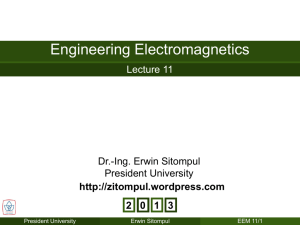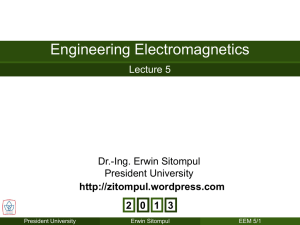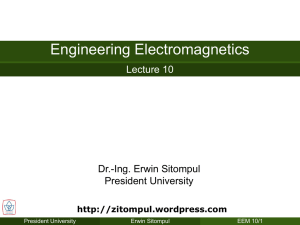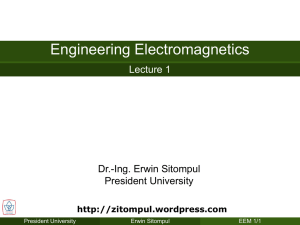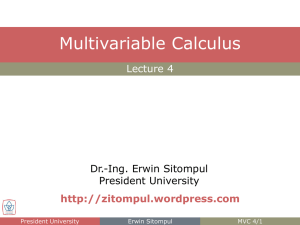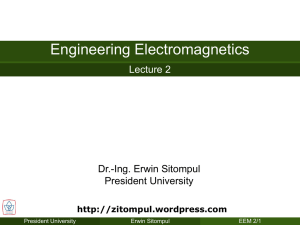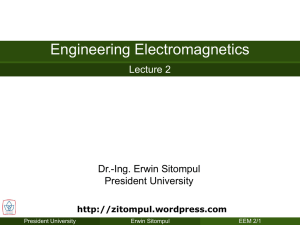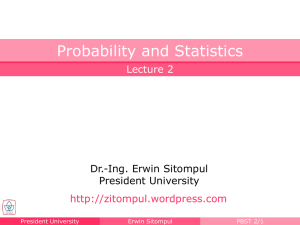ρ - Erwin Sitompul
advertisement
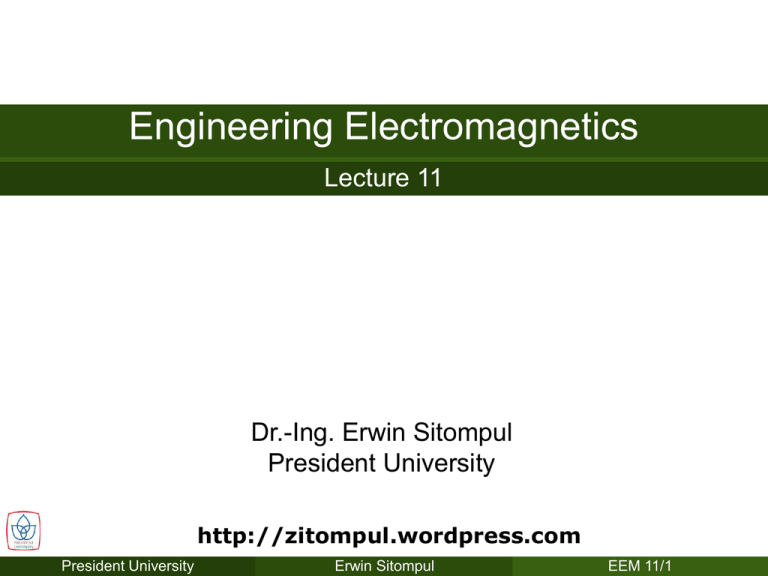
Engineering Electromagnetics Lecture 11 Dr.-Ing. Erwin Sitompul President University http://zitompul.wordpress.com President University Erwin Sitompul EEM 11/1 Chapter 8 The Steady Magnetic Field Ampere’s Circuital Law In solving electrostatic problems, whenever a high degree of symmetry is present, we found that they could be solved much more easily by using Gauss’s law compared to Coulomb’s law. Again, an analogous procedure exists in magnetic field. Here, the law that helps solving problems more easily is known as Ampere’s circuital law. The derivation of this law will waits until several subsection ahead. For the present we accept Ampere’s circuital law as another law capable of experimental proof. Ampere’s circuital law states that the line integral of magnetic field intensity H about any closed path is exactly equal to the direct current enclosed by that path, H dL I President University Erwin Sitompul EEM 11/2 Chapter 8 The Steady Magnetic Field Ampere’s Circuital Law • The line integral of H about the closed path a and b is equal to I • The integral around path c is less than I. The application of Ampere’s circuital law involves finding the total current enclosed by a closed path. President University Erwin Sitompul EEM 11/3 Chapter 8 The Steady Magnetic Field Ampere’s Circuital Law Let us again find the magnetic field intensity produced by an infinite long filament carrying a current I. The filament lies on the z axis in free space, flowing to az direction. We choose a convenient path to any section of which H is either perpendicular or tangential and along which the magnitude H is constant. The path must be a circle of radius ρ, and Ampere’s circuital law can be written as 2 H dL H d 0 President University 2 H d H 2 I H 0 Erwin Sitompul EEM 11/4 I 2 Chapter 8 The Steady Magnetic Field Ampere’s Circuital Law As a second example, consider an infinitely long coaxial transmission line, carrying a uniformly distributed total current I in the center conductor and –I in the outer conductor. A circular path of radius ρ, where ρ is larger than the radius of the inner conductor a but less than the inner radius of the outer conductor b, leads immediately to I H ( a b) 2 If ρ < a, the current enclosed is I encl 2 H I 2 a2 Resulting H I ( a) 2 2 a President University Erwin Sitompul EEM 11/5 Chapter 8 The Steady Magnetic Field Ampere’s Circuital Law If the radius ρ is larger than the outer radius of the outer conductor, no current is enclosed and H 0 ( c) Finally, if the path lies within the outer conductor, we have 2 b2 2 H I I 2 2 c b I c2 2 H 2 c 2 b2 (b c) • ρ components cancel, z component is zero. • Only φ component of H does exist. President University Erwin Sitompul EEM 11/6 Chapter 8 The Steady Magnetic Field Ampere’s Circuital Law The magnetic-field-strength variation with radius is shown below for a coaxial cable in which b = 3a, c = 4a. It should be noted that the magnetic field intensity H is continuous at all the conductor boundaries The value of Hφ does not show sudden jumps. Outside the coaxial cable, a complete cancellation of magnetic field occurs. Such coaxial cable would not produce any noticeable effect to the surroundings (“shielding”) President University Erwin Sitompul EEM 11/7 Chapter 8 The Steady Magnetic Field Ampere’s Circuital Law As final example, consider a sheet of current flowing in the positive y direction and located in the z = 0 plane, with uniform surface current density K = Kyay. Due to symmetry, H cannot vary with x and y. If the sheet is subdivided into a number of filaments, it is evident that no filament can produce an Hy component. Moreover, the Biot-Savart law shows that the contributions to Hz produced by a symmetrically located pair of filaments cancel each other. Hz is zero also. Thus, only Hx component is present. President University Erwin Sitompul EEM 11/8 Chapter 8 The Steady Magnetic Field Ampere’s Circuital Law We therefore choose the path 1-1’-2’-2-1 composed of straightline segments which are either parallel or perpendicular to Hx and enclose the current sheet. Ampere's circuital law gives H x1L H x 2 (L) K y L H x1 H x 2 K y If we choose a new path 3-3’-2’-2’3, the same current is enclosed, giving H x3 H x 2 K y and therefore H x3 H x1 President University Erwin Sitompul EEM 11/9 Chapter 8 The Steady Magnetic Field Ampere’s Circuital Law Because of the symmetry, then, the magnetic field intensity on one side of the current sheet is the negative of that on the other side. Above the sheet H x 12 K y ( z 0) while below it H x 12 K y ( z 0) Letting aN be a unit vector normal (outward) to the current sheet, this result may be written in a form correct for all z as H 12 K aN President University Erwin Sitompul EEM 11/10 Chapter 8 The Steady Magnetic Field Ampere’s Circuital Law If a second sheet of current flowing in the opposite direction, K = –Kyay, is placed at z = h, then the field in the region between the current sheets is H K aN (0 z h) and is zero elsewhere H0 ( z 0, z h) President University Erwin Sitompul EEM 11/11 Chapter 8 The Steady Magnetic Field Ampere’s Circuital Law The difficult part of the application of Ampere’s circuital law is the determination of the components of the field which are present. The surest method is the logical application of the Biot-Savart law and a knowledge of the magnetic fields of simple form (line, sheet of current, “volume of current”). • Solenoid President University • Toroid Erwin Sitompul EEM 11/12 Chapter 8 The Steady Magnetic Field Ampere’s Circuital Law For an infinitely long solenoid of radius a and uniform current density Ka aφ, the result is H Ka a z ( a) H0 ( a) President University If the solenoid has a finite length d and consists of N closely wound turns of a filament that carries a current I, then NI well within H a z (the solenoid) d Erwin Sitompul EEM 11/13 Chapter 8 The Steady Magnetic Field Ampere’s Circuital Law For a toroid with ideal case 0 a inside H Ka a (toroid ) H0 President University For the N-turn toroid, we have the good approximations (outside toroid) Erwin Sitompul NI H a 2 H0 (inside toroid) (outside toroid) EEM 11/14 Chapter 8 The Steady Magnetic Field End of the Lecture President University Erwin Sitompul EEM 11/15
